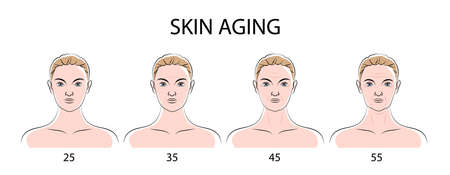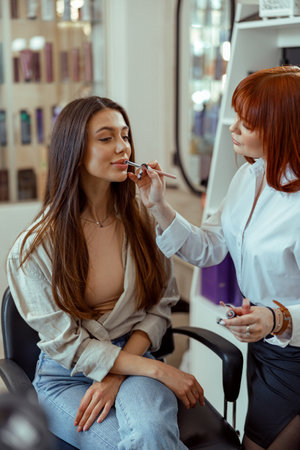Understanding Fine Lines and Why They Show Up in Your 30s
Turning thirty can feel empowering, but it’s also when many Americans start noticing the first signs of fine lines on their faces. So, what’s happening beneath the surface? Dermatologists explain that our thirties are a pivotal decade for skin changes because natural collagen and elastin production begins to slow down. These proteins keep skin firm and youthful, but as they decrease, skin becomes thinner and less resilient. Everyday facial expressions—like smiling, frowning, or squinting—start to leave more lasting marks. Add in cumulative sun exposure, environmental stressors, and lifestyle factors like sleep habits and diet, and it’s no wonder those subtle lines make their debut. Understanding why these changes happen is the first step to taking control of your skin’s future and adopting dermatologist-approved habits that can help keep your complexion smoother for longer.
2. The Power of Daily Sunscreen
When it comes to preventing fine lines in your 30s, dermatologists across the U.S. are unanimous: daily sunscreen is non-negotiable. Ultraviolet (UV) rays can damage your skin year-round—yes, even when it’s cloudy or you’re mostly indoors. According to experts, incorporating broad-spectrum SPF into your morning routine is the single most effective way to slow visible signs of aging like fine lines and wrinkles.
Why Is Daily SPF So Important?
UVA and UVB rays penetrate clouds and windows, breaking down collagen and elastin in the skin, which accelerates the formation of fine lines. Dermatologists say that just a few minutes of unprotected sun exposure each day can add up over time, leading to premature aging. That’s why they recommend making sunscreen a habit, regardless of the weather or your plans for the day.
Dermatologists’ Recommendations for SPF Use
| Situation | Recommended SPF | Application Tips |
|---|---|---|
| Everyday (indoors & cloudy days) | SPF 30+ broad-spectrum | Apply every morning on face, neck, and exposed areas |
| Outdoor Activities | SPF 50+ water-resistant | Reapply every 2 hours, especially after sweating or swimming |
| Makeup Wearers | SPF moisturizer or primer + powder SPF for touch-ups | Layer under makeup; use setting sprays with SPF for midday boosts |
Pro Tip:
If you work near windows or drive regularly, don’t skip sunscreen—UV rays can pass through glass! Look for products labeled “broad-spectrum,” meaning they protect against both UVA (aging) and UVB (burning) rays. Mineral sunscreens with zinc oxide or titanium dioxide are great options for sensitive skin types commonly seen in American adults.

3. Skincare Routine Essentials for Prevention
If you’re serious about preventing fine lines in your 30s, building a thoughtful skincare routine is essential. According to leading dermatologists, certain ingredients stand out for their ability to support youthful, resilient skin. Here’s what you should know before stocking your bathroom shelf.
Retinoids: The Gold Standard
Retinoids are vitamin A derivatives that top every dermatologist’s list for anti-aging. These powerhouse ingredients speed up cell turnover and stimulate collagen production, helping to minimize the appearance of fine lines and even out skin texture. Whether you opt for over-the-counter retinol or prescription-strength tretinoin, consistency is key—start slow and always use sunscreen during the day, as retinoids can make your skin more sensitive to sunlight.
Vitamin C: Brightening and Protecting
Vitamin C is another must-have for your 30s. As a potent antioxidant, it helps fight free radical damage caused by sun exposure and pollution—two big culprits behind premature aging. Vitamin C also boosts collagen synthesis and brightens dull skin tone. Look for serums with L-ascorbic acid (the most effective form), and apply it in the morning under your moisturizer and sunscreen.
Hyaluronic Acid: Hydration Hero
Don’t underestimate the power of hydration when it comes to preventing fine lines. Hyaluronic acid is a moisture-binding ingredient that draws water into the skin, plumping it up and smoothing out fine creases. Layer a hyaluronic acid serum before your moisturizer to lock in lasting hydration without feeling greasy—a win for all skin types.
Bonus Tips from Dermatologists
- Apply sunscreen every single day, rain or shine—UV damage accelerates fine line formation faster than anything else.
- Keep your routine simple but consistent. Overloading on too many active ingredients can irritate your skin.
- If you’re unsure where to start, consult with a board-certified dermatologist to personalize your regimen based on your skin’s unique needs.
By focusing on these expert-backed essentials, you’ll be taking proactive steps toward maintaining smooth, healthy-looking skin well into your 30s—and beyond.
4. Healthy Lifestyle Habits That Make a Difference
When it comes to preventing fine lines in your 30s, dermatologists agree that your everyday lifestyle choices can have a big impact on your skin’s health and appearance. Get inspired to leverage nutrition, hydration, quality sleep, and stress reduction to keep your skin looking youthful, radiant, and resilient.
Nutrition: Feed Your Skin from Within
The foods you eat play a critical role in supporting your skin’s structure and function. Dermatologists recommend focusing on a colorful, balanced diet packed with antioxidants, healthy fats, vitamins, and minerals. These nutrients help fight off free radicals and support collagen production, both of which are essential for minimizing fine lines.
| Skin-Boosting Nutrient | Where to Find It | Benefit for Fine Lines |
|---|---|---|
| Vitamin C | Citrus fruits, strawberries, bell peppers | Promotes collagen synthesis and brightens skin |
| Omega-3 Fatty Acids | Salmon, walnuts, flaxseeds | Keeps skin plump and hydrated |
| Antioxidants | Berries, leafy greens, green tea | Protects against environmental damage |
| Zinc & Selenium | Pumpkin seeds, eggs, Brazil nuts | Supports skin repair and renewal |
Hydration: Water Is Your Skin’s Best Friend
Staying hydrated is one of the simplest ways to keep your skin looking supple and youthful. Aim for at least eight cups of water a day—more if you’re active or live in a dry climate. Pro tip: carry a reusable water bottle so you always have hydration on hand. If plain water gets boring, infuse it with lemon or cucumber for an extra boost of flavor (and antioxidants!). Herbal teas count too!
Quality Sleep: The Overnight Glow-Up
Your body repairs itself while you sleep—including your skin! Most dermatologists recommend seven to nine hours per night for optimal cell turnover and recovery. Sleeping on your back can also reduce pressure on your face and minimize sleep lines. Try winding down with calming activities like reading or gentle yoga before bed to set yourself up for restful slumber.
Stress Reduction: Calm Mind, Smooth Skin
Chronic stress triggers the release of cortisol, which can break down collagen and exacerbate fine lines. Build stress-reducing practices into your daily routine—think meditation apps, deep breathing exercises, spending time outdoors, or connecting with friends and family. Even a few minutes a day can make a noticeable difference for both your mental health and your complexion.
Small Changes Add Up!
You don’t have to overhaul your life overnight to see results. Start with one or two habits that feel doable for you—like swapping chips for berries at snack time or adding an extra glass of water after lunch—and build from there. Over time, these simple adjustments add up to healthier skin that glows from the inside out.
5. Professional Treatments: When to Consider an Expert
Sometimes, even with the best at-home skincare routine, you might notice fine lines starting to form or deepen in your 30s. That’s when it could be time to consult a board-certified dermatologist for advanced solutions. While over-the-counter products can help slow signs of aging, professional treatments offer targeted results that are tough to match on your own.
Understanding Your Options
Dermatologists have access to a wide range of advanced procedures designed to boost collagen, smooth texture, and reduce the appearance of fine lines. Popular options include chemical peels, which exfoliate dead skin cells and encourage cell turnover for a brighter, more youthful complexion. There’s also microneedling, where tiny needles create micro-injuries in the skin to stimulate natural collagen production—a favorite among dermatology pros for its impressive results with minimal downtime.
Who Should Consider These Treatments?
If you’re noticing persistent fine lines that don’t respond to serums or moisturizers, or if you want quicker, more dramatic improvements, professional treatments may be worth exploring. They’re especially helpful for people with busy lifestyles who want visible results without waiting months. Plus, these options can be tailored to your unique skin type and concerns by an expert who understands the nuances of skin health.
When Is the Right Time to Book a Consultation?
It’s smart to see a dermatologist sooner rather than later if you have questions about your skin changes, want personalized recommendations, or are considering treatments like chemical peels or microneedling. Early intervention can make a big difference in preventing deeper wrinkles down the line. Remember, investing in your skin is just another way of practicing self-care—and you deserve expert support on your journey to healthy, radiant skin!
6. Myths vs. Facts: Debunking Common Skincare Beliefs
Separate Realities from Social Media Myths
When it comes to preventing fine lines in your 30s, social media can be a double-edged sword. While there’s a wealth of information out there, not all of it is accurate—or even safe. Let’s break down some of the most common misconceptions and get clarity from board-certified dermatologists.
Myth #1: Expensive Products Work Better
It’s easy to believe that a high price tag equals better results. However, dermatologists agree that effective ingredients—like retinoids, vitamin C, and sunscreen—are available at every price point. What matters is consistency and choosing products that suit your skin type, not the brand’s prestige.
Myth #2: Natural Ingredients Are Always Safer
While natural skincare can sound appealing, “natural” doesn’t always mean safer or more effective. Poison ivy is natural, too! Some botanical ingredients can cause allergies or irritation. Board-certified experts recommend patch testing new products and looking for clinically proven formulas instead of just following trends.
Myth #3: You Don’t Need Sunscreen Indoors
This is a big one—UV rays can penetrate windows and contribute to fine lines even if you’re working from home. Dermatologists stress that daily sunscreen use (SPF 30 or higher) is non-negotiable for real wrinkle prevention, regardless of the weather or your indoor/outdoor routine.
Myth #4: Moisturizer Alone Prevents Fine Lines
While hydration helps plump up the skin temporarily, moisturizer alone won’t stop fine lines in their tracks. Experts recommend pairing moisturizers with targeted actives like retinol or peptides for best results. Prevention is about a holistic routine—not just one miracle product.
The Bottom Line: Trust Science Over Hype
Your 30s are a great time to build healthy skincare habits that last. Rely on evidence-based advice from professionals rather than viral trends, and don’t hesitate to consult a dermatologist for personalized guidance tailored to your unique skin needs.


